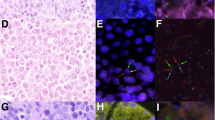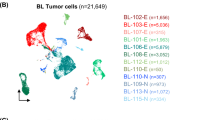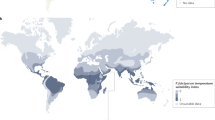Point mutations in the c–Myc transactivation domain are common in Burkitt's lymphoma and mouse plasmacytomas (original) (raw)
- Article
- Published: 01 September 1993
Nature Genetics volume 5, pages 56–61 (1993)Cite this article
- 1664 Accesses
- 253 Citations
- 3 Altmetric
- Metrics details
Abstract
We have screened the entire coding region of c–myc in a panel of Burkitt's lymphomas (BLs) and mouse plasmacytomas (PCTs). Contrary to the belief that c–myc is wild type in these tumours, we found that 65% of 57 BLs and 30% of 10 PCTs tested exhibit at least one amino acid (aa) substitution. These mutations were apparently homozygous in all BL cell lines tested and two tumour biopsies, implying that the mutations often occur before Myc/lg translocation in BL. In PCTs, only the mutant c–myc allele was expressed indicating a functional homozygosity, but occurrence of mutations after the translocation. Many of the observed mutations are clustered in regions associated with transcriptional activation and apoptosis, and in BLs, they frequently occur at sites of phosphorylation, suggesting that the mutations have a pathogenetic role.
This is a preview of subscription content, access via your institution
Access options
Subscribe to this journal
Receive 12 print issues and online access
$209.00 per year
only $17.42 per issue
Buy this article
- Purchase on SpringerLink
- Instant access to full article PDF
Prices may be subject to local taxes which are calculated during checkout
Additional access options:
Similar content being viewed by others



Burkitt lymphoma
Article 15 December 2022
References
- Marcu, K.B., Bossone, S.A. & Patel, A.J. Myc function and regulation. Ann. Rev. Biochem. 61, 809–860 (1992).
Article CAS Google Scholar - Prendergast, G.C. & Ziff, E.B. A new bind for myc. Trends Genet. 8, 91–96 (1992).
Article CAS Google Scholar - Depinho, R.A., Schreiber-Agus, N. & Alt, F.W. Myc family oncogenes in the development of normal and neoplastic cells. Adv. cancer Res. 57, 1–46 (1991).
Article CAS Google Scholar - Cole, M. The myc oncogene: its role in transformation and differentiation. Adv. cancer Res. 20, 361–384 (1986).
CAS Google Scholar - Potter, M. & Wiener, F. Plasmacytomagenesis in mice: model; model of neoplastic development dependent upon chromosomal translocations. Carcinogenesis 13, 1681–1697 (1992).
Article CAS Google Scholar - Magrath, I. The pathogenesis of Burkitt's lymphoma. Adv. cancer Res. 55, 133–270 (1990).
Article CAS Google Scholar - Evan, G.I. et al. Induction of apoptosis in fibroblasts by c–Myc protein. Cell 69, 119–128 (1992).
Article CAS Google Scholar - Wyllie, A.H. et al. Rodent fibroblast tumours expressing human myc and ras genes: growth, metastasis and endogenous oncogene expression. Br. J. Cancer 56, 251–259 (1987).
Article CAS Google Scholar - Askew, D., Ashmun, R., Simmons, B. & Cleveland, J. Constitutive c–myc expression in IL–3 dependent myeloid cell line suppresses cycle arrest and accelerates apoptosis. Oncogene 6, 1915–1922 (1991).
CAS Google Scholar - Shi, Y. et al. Role for c–myc in activation-induced apoptotic cell death in T cell hybridomas. Science 257, 212–214 (1992).
Article CAS Google Scholar - Magrath, I., Jain, V. & Bhatia, K. Epstein-Barr virus and Burkitt's lymphoma. Sem. Cancer Biol. 3, 285–295 (1992).
CAS Google Scholar - Rabbitts, T.H., Hamlyn, R.H. & Baer, R. Altered nucleotide sequences of a translocated c–myc gene in Burkitt lymphoma. Nature 306, 760–765 (1983).
Article CAS Google Scholar - Rabbitts, T.H., Forster, A., Hamlyn, P. & Baer, R. Effect of somatic mutations within translocated c–myc genes in Burkitt lymphoma. Nature 309, 592–597 (1984).
Article CAS Google Scholar - Legouy, E. et al. Structure and expression of the murine L–myc gene. The EMBO J. 6, 3359–3366 (1987).
Article CAS Google Scholar - Gupta, S., Seth, A. & Davis, R.J. Transactivation of gene expression by Myc is inhibited by mutation at the phosphorylation sites Thr–58 and Ser–62. Proc. natn. Acad. Sci. U.S.A. 90, 3216–3220 (1993).
Article CAS Google Scholar - Gu, W., Cechova, K., Tassi, V. & Dalla-Favera, R. Opposite regulation of gene transcription and cell proliferation by c–Myc and Max. Proc. natn. Acad. Sci. U.S.A. 90, 2935–2939 (1993).
Article CAS Google Scholar - Seth, A., Alvarez, E., Gupta, S. & Davis, R.J. A phosphorylation site located in the NH2-terminal domain of c–Myc increases transactivation of gene expression. J. biol. Chem. 266, 23521–23524 (1991).
CAS PubMed Google Scholar - Potter, M. et al. Avian v–myc replaces chromosomal translocation in murine plasmacytomagenesis. Science 235, 787–789 (1987).
Article CAS Google Scholar - Cory, S. Activation of cellular oncogenes in hemopoietic cells by chromosome translocation. Adv. cancer Res. 47, 189–234 (1986).
Article CAS Google Scholar - Suen, T.-C. & Hung, M.-C. & Hung, M.-C. c–myc reverses neu-induced transformed morphology by transcriptional repression. Molec. cell. Biol. 11, 354–362 (1991).
Article CAS Google Scholar
Author information
Authors and Affiliations
- Pediatric Branch, Clinical Oncology Program, Building 10 Room 13N240, NCI/NIH, Bethesda, Maryland, 20892, USA
K. Bhatia, G. Spangler, R. Iyer & I. Magrath - Molecular Genetics Section, Laboratory of Genetics, NCI/NIH, Bethesda, Maryland, 20892, USA
K. Huppi & D. Siwarski
Authors
- K. Bhatia
- K. Huppi
- G. Spangler
- D. Siwarski
- R. Iyer
- I. Magrath
Rights and permissions
About this article
Cite this article
Bhatia, K., Huppi, K., Spangler, G. et al. Point mutations in the c–Myc transactivation domain are common in Burkitt's lymphoma and mouse plasmacytomas.Nat Genet 5, 56–61 (1993). https://doi.org/10.1038/ng0993-56
- Received: 26 February 1993
- Accepted: 23 June 1993
- Issue Date: 01 September 1993
- DOI: https://doi.org/10.1038/ng0993-56